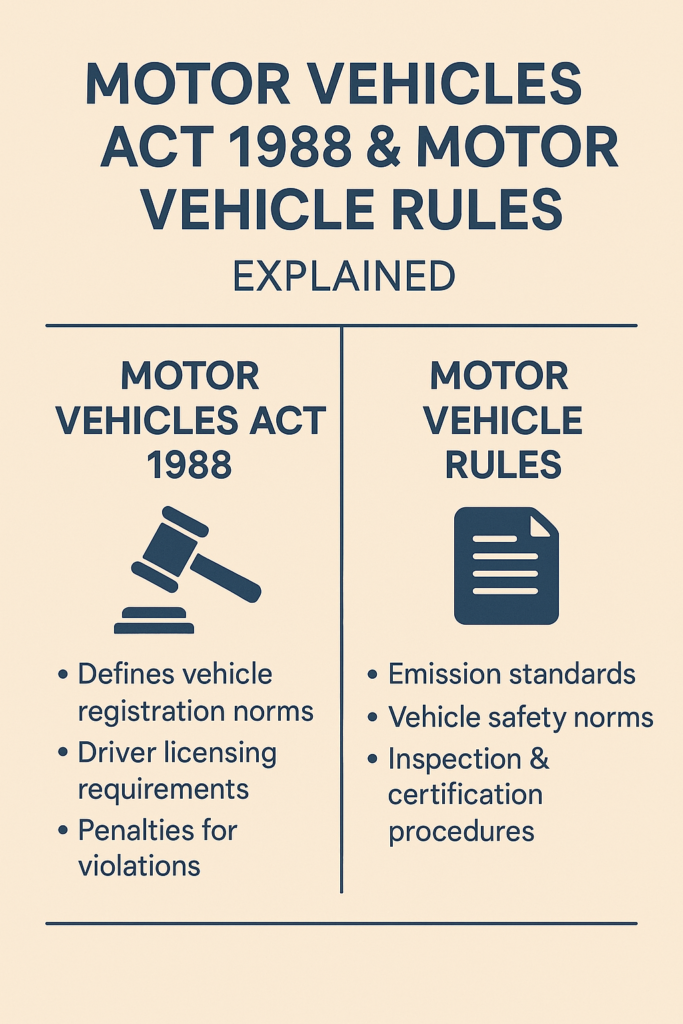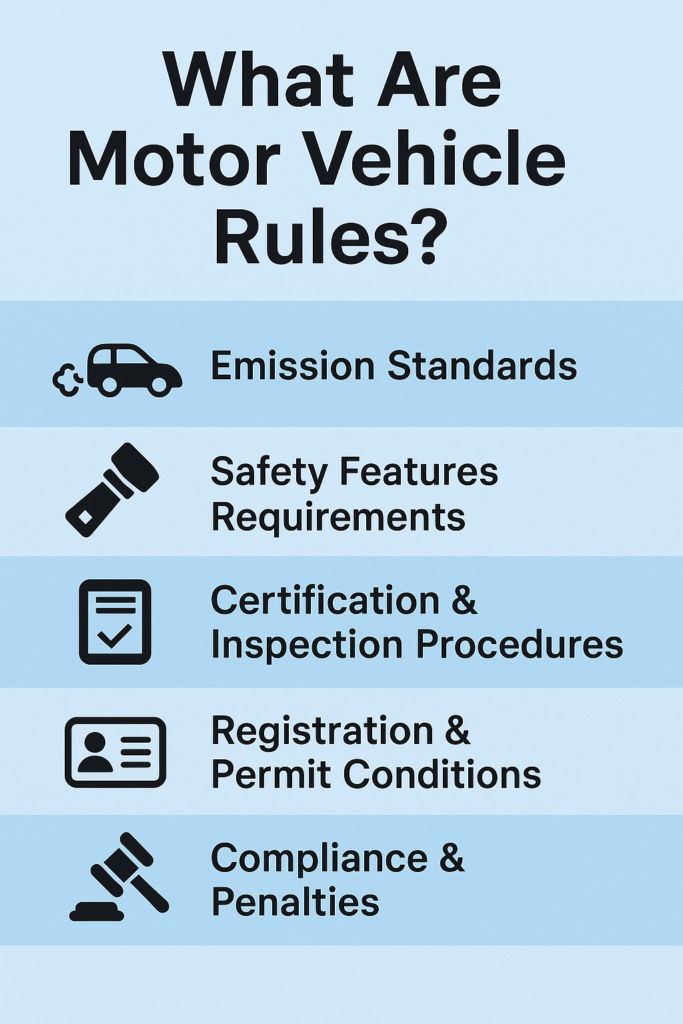Motor Vehicles Act 1988
The Motor Vehicles Act 1988 is the cornerstone of road transport law in India. It governs everything from vehicle registration to traffic regulations, licensing, and penalties for violations. If you drive or own a vehicle, understanding this act is essential for staying legal and safe on the road.
Alongside the act are the Motor Vehicle Rules, which provide detailed guidelines and procedures to implement the law effectively. Together, they form the backbone of India’s road safety and vehicle management system.
In this article, we’ll break down the Motor Vehicles Act 1988, highlight its key provisions, and explain how the motor vehicle rules support its implementation.

Overview of the Motor Vehicles Act 1988
The Motor Vehicles Act 1988 is a comprehensive legislation passed to regulate all aspects of road transport in India. It covers:
- Registration and licensing of vehicles and drivers
- Road safety and traffic management
- Insurance requirements for vehicles
- Penalties and fines for traffic violations
- Compensation for accident victims
- Regulation of motor vehicle transport services
The act aims to improve road safety, reduce accidents, and streamline vehicle administration across states.
Importance of the Motor Vehicles Act for Drivers and Vehicle Owners
The Motor Vehicles Act 1988 is crucial because it:

- Ensures Legal Compliance: It sets the rules every driver and vehicle owner must follow to operate legally on Indian roads.
- Promotes Road Safety: Through licensing, vehicle standards, and traffic regulations, it helps reduce accidents and fatalities.
- Defines Penalties: The act clearly outlines fines and punishments for violations, encouraging responsible driving.
- Protects Victims: It provides compensation mechanisms for accident victims and their families.
- Regulates Commercial Transport: Ensures commercial vehicles meet standards for safety and fair operation.
- Supports Environmental Goals: Through emission standards and regulations, it helps control vehicular pollution.
Without this act, maintaining order and safety on India’s roads would be nearly impossible.
Key Provisions in the Motor Vehicles Act 1988
The Motor Vehicles Act 1988 includes several important provisions that every driver and vehicle owner should know:
- Vehicle Registration: All motor vehicles must be registered with the Regional Transport Office (RTO) before they can be driven legally.
- Driving Licenses: Drivers must obtain a valid driving license for the type of vehicle they operate.
- Road Safety Measures: The act sets rules for wearing helmets, seat belts, speed limits, and driving under influence of alcohol or drugs.
- Insurance: Third-party insurance is mandatory to cover damages or injuries caused by the vehicle.
- Traffic Violations and Penalties: The act defines fines and penalties for offenses like overspeeding, signal jumping, drunk driving, and unauthorized vehicle use.
- Accident Claims and Compensation: It provides guidelines for compensation to victims of road accidents.
- Fitness Certificates: Commercial vehicles must obtain fitness certificates to ensure they are roadworthy.
- National Permit: The act regulates the issuance of permits for interstate transport of goods and passengers.
These provisions work together to regulate traffic, promote safety, and ensure accountability
What Are Motor Vehicle Rules?
Motor Vehicle Rules are detailed regulations framed under the Motor Vehicles Act to implement its provisions effectively. They cover specifics like:

- Procedure for issuing driving licenses and registration certificates
- Conditions for vehicle operation and permits
- Rules for traffic signs, signals, and road safety measures
- Penalties and procedures for enforcement
- Guidelines for vehicle fitness testing and emission standards
These rules help translate the Act’s broad principles into actionable, enforceable steps on the ground.
Recent Amendments and Updates to the Motor Vehicles Act
The Motor Vehicles Act 1988 has undergone several amendments to address emerging challenges:
- Increased Fines: Penalties for traffic violations have been significantly raised to deter reckless driving.
- Stricter Licensing Norms: Tighter rules for issuing driving licenses, including mandatory training.
- Enhanced Safety Regulations: Mandatory helmets, seat belts, and airbags in vehicles.
- E-Services: Introduction of online services like driving license renewal, vehicle registration, and challan payments via portals like Parivahan Sewa.
- Green Initiatives: Emission norms aligned with environmental goals, promoting electric and cleaner vehicles.
These changes aim to improve road safety and make compliance easier for citizens.
How the Act Impacts Road Safety and Vehicle Regulations
By enforcing strict rules and penalties, the Act has helped reduce road accidents and fatalities. It ensures only qualified drivers operate vehicles and that vehicles meet safety and environmental standards. Regular fitness tests and permits ensure commercial vehicles are roadworthy, while insurance requirements protect accident victims.
The Act’s framework also supports smoother traffic management and helps law enforcement maintain order on busy roads.
Quick Guide to Motor Vehicles Act 1988 in Hindi
For those searching motor vehicle act 1988 in hindi, here’s a quick overview:
मोटर व्हीकल एक्ट 1988 भारत में सड़क परिवहन को नियंत्रित करने वाला मुख्य कानून है। यह ड्राइवरों, वाहनों के पंजीकरण, लाइसेंसिंग, सड़क सुरक्षा, दुर्घटना मुआवजा और ट्रैफिक नियमों को विनियमित करता है। हाल के संशोधनों ने जुर्माने बढ़ाए हैं और ऑनलाइन सेवाओं को लागू किया है जिससे नागरिकों के लिए नियमों का पालन आसान हो गया है।
